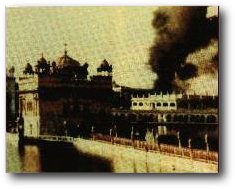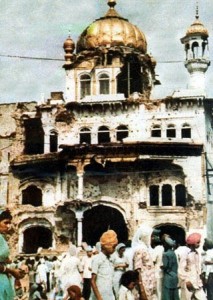Articles/Opinion » Sikh Genocide 1984
Memory of the Darbar SAhib Tragedy – by Sajjad Shaukat*
June 8, 2010 | By Sikh Siyasat Bureau
June 5 and June 6 are reminders of the ‘Operation Blue Star’ when Indian military, led by General Kuldip Singh Brar, launched attack on the [Darbar Sahib], the holiest shrine of Sikhs in 1984, to arrest Jarnail Singh Bhindranwale, the only leader who had been boldly fighting for the rights of Sikhs. The Indian Army supported by troops and armoured vehicles broke all records of the state terrorism and extra-judicial killings through that barbaric operation.
It is notable that at that time, there were only 251 Sikhs inside the complex to protect the [Darbar Sahib], resisting well-trained Indian army, equipped with sophisticated weaponry. In those days, majority of the Sikhs were coming to [Darbar Sahib] to celebrate Martyr Day of Guru Arjan Dev Ji.
Then the Indian regime used tanks and destroyed the Akaal Takhat Sahib which is right in front of the [Darbar Sahib]. On June 6, when all Sikh fighters were martyred along with Jarnail Singh Bhindranwale, Indian troops entered the temple with their shoes by even deliberately ignoring the holiness of the place, showing utter indecency. When the Indian Army felt that only 251 men had prevented them from entering the temple for so many days, they started killing innocent Sikhs who had come there to visit the Temple. The only purpose was to hide their humiliation.
In connection with that incident of state terrorism, Ramnarain Kumar and George Sieberer in their book, The Sikh struggle, write: “The army killed every Sikh who could be found inside the temple complex. They were hauled out of rooms, brought to corridors on the circumference of the temple and with their hands tied behind their back, were shot in cold blood. Among the victims were many old men, women and children.” However, all visitors were locked up in rooms for two days without any food, water, or electricity and were starved to death. Besides, the [Darbar Sahib] remained under the army control for many nonths.”
The brutality of the ‘Operation Blue Star’ was not confined to the [Darbar Sahib]. Indian armed forces simultaneously attacked 40 other historical gurdwaras all over East Punjab. When Sikhs in other states came to know about the desecration of the [Darbar Sahib] and massacre of their brethren, they quickly left for Punjab. New Delhi turned its attention to Sikh military and tried to stop them before they could reach Punjab. Many Sikhs were assassinated on the way and many others were arrested. According to an estimate, about 50,000 Sikhs were killed within a few days. The whole Amritsar city was sealed and was burnt. A number of tourists either were murdered or arrested. Shops belonging to Sikhs were looted and their houses were set ablaze by Hindu mobs. In most of the cases, Sikh women were molested and some persons of their community were also burnt.
Another tragic dimension of the military operation is that historical Sikh artifacts all the literature written by the gurus was taken away by the army and was also set ablaze. In this regard, New Delhi claimed that it was burnt while bombing the Temple.
In November of the same year, two dedicated Sikhs named Beant Singh and Satwant Singh who were posted at Premier Indira Gandhi’s residence in New Delhi, assassinated her. Then Hindu riots erupted in the capital and other cities in which more then 15,000 Sikhs were killed in broad daylight by the supporters of Indira Gandhi while police watched silently so as to provide the Hindus with free hand to massacre Sikhs. The attack on the [Darbar Sahib] and genocide of Sikhs only accelerated the liberation movement for Khalistan as Bhindrenwale bacame a folk hero.
Meanwhile, after ‘Operation Blue Star’ and the Sikh genocide, Sikhs’ struggle for independence continued, but the Indian government made every effort to crush the same with the state machinery. To maintain their control over the [Darbar Sahib], another attack was launched on the Temple in 1987, called ‘Operation Black Thunder’. This time only Sikh resistance was the main target. In that respect, quite a number of people of their community were killed and dead bodies lay inside the sacred place for many days. According to a report, many trucks were loaded with dead bodies and all were burned with kerosene oil. Afterwards, ‘Operation Woodrose’ and ‘Operation Black Thunder-II’ were conducted against the Sikh community, which also assassinated them extra-judicially.
After these barbaric operations, Sikhs organised themselves into an armed power in order to fight the Indian state terrorism. Many Sikhs left India to escape religious persecution. Sikhs have spread out all over the world to keep the movement of Khalistan alive. In this respect, their struggle is still going on.
It is of particular attention that the Indian government dominated by politicians from the Hindi heartland uses force ruthlessly against any move to free Assam, Kashmir, Khalistan, Mizoram, Nagaland, Tamil Nadu and Tripura.
Consequently, ‘Operation Blue Star’ was one of the most inflammatory actions ever taken by the Indian government. Still, coupled with intermittent massacre of Muslims and Christians, including that of the lower caste communities tends to expose the real face of New Delhi. Ground realities display that India is a fundamentalist state under the mask of secularism. And the tragedy of ‘Operation Blue Star’ and its drastic aftermath has, without any doubt, endorsed this fact.
* Sajjad Shaukat writes on international affairs and is author of the book: US vs Islamic Militants, Invisible Balance of Power: Dangerous Shift in International Relations.
To Get Sikh Siyasat News Alerts via WhatsApp:
(1) Save Our WhatsApp Number 0091-855-606-7689 to your phone contacts; and
(2) Send us Your Name via WhatsApp. Click Here to Send WhatsApp Message Now.
Sikh Siyasat is on Telegram Now. Subscribe to our Telegram Channel
Related Topics: 1984 Sikh Genocide, Indian State, June 1984 attack on Sikhs, November 1984






